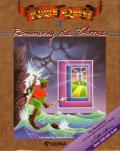There are few things more fun than browsing through a big used game collection at a hobby store—you never know what you’re going to find.
There’s a comic store near my house that has a selection of used games. I usually don’t pay it too much attention when I visit the store, since I’ve combed through the used section in the past and already snatched up the stuff that interests me. But for the last year or two, I’ve been tempted by, of all things… (drum roll, please) this:
That is, of course, a copy of Cyborg Commando, a Gary Gygax creation and one of the worst games ever published, if internet scuttlebutt is to be believed. Every few months I would stop by this store, see that slightly battered game box on the shelf (for just a few measly bucks!), and after a fierce internal debate, I’d successfully make my saving throw vs. Buy More Games I’ll Probably Never Play.
But recently, in a moment of weakness, I decided that I just had to have this artifact of gaming history. It’s by Gary Gygax, for crying out loud! How bad can it possibly be? (Pretty bad, actually; but that’s a story for another day.)
So I picked it up, trundled home with my prize, and retreated into the basement, after a brief exchange with my wife:
Me: I stopped by the comic store and picked up this game!
Wife: Cool—what is it?
Me (excitedly): It’s called Cyborg Commando. It’s widely considered one of the worst roleplaying games ever published!
Wife: …
Safely downstairs, I prised open the box. The old-papery smell of a dusty TSR-era boxed set filled the air:
Two rulebooks, some sort of short adventure-looking booklet, and some dice. A little on the meager side, but this is gaming history I’m experiencing, so that’s OK. But wait! What’s this on the inside cover?
Unless I’m mistaken, those are the signatures of Gary Gygax and Frank Mentzer themselves! (Too bad the owner of this boxed set didn’t get Kim Mohan’s signature as well, for completeness’ sake; alas.) The writing in the top left (in what looks like Gygax’s handwriting) says “At Gencon XX, 1987.” Gencon 1987 was the same year Cyborg Commando was released, so the publisher may have been selling signed copies at their booth at the convention.
What a cool surprise! It actually is a piece of gaming history. It’s not as cool as having an actual vintage D&D book signed by Gygax, but it somehow feels even nerdier, which is good. I also suspect there’s no shortage of signed Gygax books out there, given his decades-long involvement in the hobby—but this is the only Gygax signature in my collection, so it’s pretty special. I may never play this game, but it sits proudly atop my gaming bookshelf.



 Many, many people have in the last few days written eloquent tributes to
Many, many people have in the last few days written eloquent tributes to  Tonight we participated in what some are calling “GaryCon”—a game of dungeon-crawling, kobold-killing, treasure-looting D&D in memory of Gary. I ran the players through a mostly improvised dungeon populated by skeletons, giant rats, and an owlbear, and remembering Gary’s DMG advice not to coddle players, I even managed to kill one of them with said owlbear. It was not the best game I’ve ever run, nor was it the worst: it was just a good game, and that seemed perfectly appropriate.
Tonight we participated in what some are calling “GaryCon”—a game of dungeon-crawling, kobold-killing, treasure-looting D&D in memory of Gary. I ran the players through a mostly improvised dungeon populated by skeletons, giant rats, and an owlbear, and remembering Gary’s DMG advice not to coddle players, I even managed to kill one of them with said owlbear. It was not the best game I’ve ever run, nor was it the worst: it was just a good game, and that seemed perfectly appropriate.